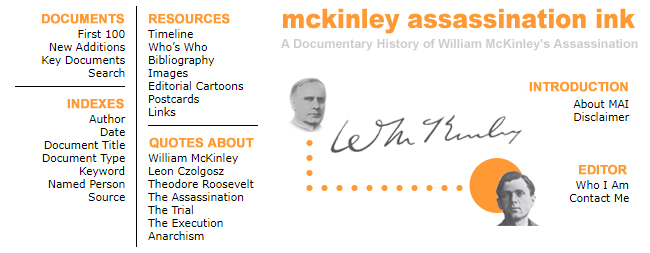|
Parker in Baltimore
DELIVERS A LECTURE IN JOHN WESLEY M. E. CHURCH.
——
Tells How He Saved the Late President from a Third Shot—Thinks the
Court
That Tried Czolgosz Should Have Summoned Him During the Trial—No
Mention of Parker Was Made in Any Way—Probably the Detectives Want
to Take All the Glory—A Fair Sized Audience.
Notwithstanding the pour down of
rain a fair-sized audience greeted James B. Parker, the Afro-American
who saved the late President McKinley from a third shot from the
pistol of his assassin. While Mr. Parker is a giant in stature,
he is a most modest man, and told his simple story in a way that
carried conviction with it.
It will be remembered that the great
white journals of New York city [sic] and the journals of
Buffalo were the first ones to give Parker the credit of being the
only man in that vast audience who had the presence of mind to grapple
at once with the assassin. Two shots had been fired from a revolver,
which was fully loaded, and more shots would have been fired had
not the assassin been stopped in time. The New York papers gave
a full and graphic account of the incident and gave Parker full
credit for his heroic act. Since that time, however, the newspapers
and others have had as little to say about the matter as possible.
But while they have had little or nothing to say, not one of them
have denied Parker’s assertions.
Mr. Parker was introduced by former
Councilman Cummings, and among other things said:
“As you all know,[”] said he, [“]I
was standing near the President that day and I did my best under
the circumstances. I would have given my life to have been able
to save the President’s life and taken Czolgosz’s bullet into my
body.
“I don’t know why so many people have
tried to deprive me of the credit of having attempted to save the
president nor do I know why I was not called to give my testimony
before the court when Czolgosz was tried. Probably the detectives
want to take all the credit. But I am certain that if the President
were alive today he would say that I was the first one to strike
down Czolgosz and prevented him from firing another bullet.
“The President was standing in the
Temple of Music, Mr. Milburn being on his right and Mr. Gage on
his left. Czolgosz was directly in front of me in the line. I noticed
that he was moving very slowly, and I tried to pass him, but he
restrained me with his elbow. I did not observe the handkerchief
over his hand until the president extended his hand to the assassin.
As he did so I glanced down, and, being a much taller man, saw the
bandage plainly. Almost instantly two shots rang out in quick succession.
As the president fell I swung Czolgosz around with my left arm and
struck him a terrific blow on the nose. As I struck the blow I grabbed
for the revolver. I missed the revolver and grabbed him by the throat.
“One of the special officers caught
the pistol from Czolgosz [sic] hand, and the crowd, mistaking him
for the assassin, commenced to assault him. ‘I’m not the man,’ he
cried, and then the crowd came to where I was kneeling upon Czolgosz.
I had my knee pressing him to the floor, and a couple of artillerymen
struck him across the head.
“Some of the men, however, helped
me to raise him off the floor and we carried him into a side room.
There we threw him on the table as though he were a bag of rags,
and, in truth, he seemed to be dead[.] We searched him, but found
nothing of any value.
“The crowd became so dense that it
was best to move the prisoner, and he was driven off to the police
station in a carriage, the crowd following after. This was the last
I saw of him.
“I did not see the president after
the shooting until he was laid in state at Buffalo. This is a correct
version of the affair.[”]
Mr. Parker left on Thursday for Washington,
D. C., where he will lecture on October 8, at Metropolitan A. M.
E. Church.
|


![]()